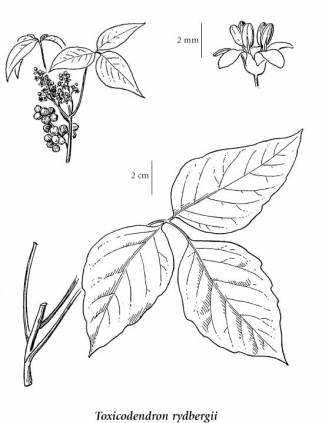Toxicodendron rydbergii (Small ex Rydb.) Greene
poison ivy (western poison ivy)
Anacardiaceae (Sumac family)
Introduction to Vascular Plants
poison ivy (western poison ivy)
Anacardiaceae (Sumac family)
Introduction to Vascular Plants
Photograph
© Gordon Neish (Photo ID #23653)
Introduction
Western poison ivy is a native species that is found across the US and Canada (excluding a cluster of states in the southeastern US, Alaska, California, Nunavut, and the Northwest Territories) (USDA 2010). Disjunct populations are reported from mountaintops of the central Appalachians (McMurray 1988). In British Columbia, it may be encountered in south-central regions and particularly in the Okanagan Valley. Throughout its range, it occurs on a variety of habitats ranging from riverbanks and lakeshores at low elevations to subalpine sites. In BC, it is most often noticed along river and lake shorelines (e.g. Vaseaux Lake) where it is moderately abundant. It is a distinctive, usually erect, rhizomatous small shrub up to 2 m in height. It most often occurs as a subshrub (McMurray 1988). Branching is simple. It has three shiny, pointed leaves and numerous monecious flowers occur in dense clusters in the leaf axils. Berries are white, sometimes greenish-yellow. Leaves often appear slightly drooping and exude milky sap when broken or cut. Western poison ivy can cause dermatological reactions when touched, resulting in an itchy rash, and should not be handled.
|
Species Information
General:
Deciduous slender shrub, decumbent to erect, ivylike, up to 2 m tall, somewhat hairy, exuding milky juice when cut.
Leaves:
Leaflets 3, abruptly sharp-pointed or long-pointed, broadly egg-shaped, entire or shallowly crenate to lobed, 5-15 cm long.
Flowers:
Inflorescence of crowded axillary panicles; flowers 2-3 mm long.
Fruits:
Berrylike drupes, 4 mm long, white to greenish-yellow, glabrous.
Notes:
The slightly volatile oils of this plant cause an allergic reaction for some people.
Illustration

If more than one illustration is available for a species (e.g., separate illustrations were provided for two subspecies) then links to the separate images will be provided below. Note that individual subspecies or varietal illustrations are not always available.
Illustration Source: The Illustrated Flora of British Columbia
Ecology
Ecological Framework for Toxicodendron rydbergii
The table below shows the species-specific information calculated from
original data (BEC database) provided by the BC Ministry of Forests and Range.
(Updated August, 2013)
The table below shows the species-specific information calculated from
original data (BEC database) provided by the BC Ministry of Forests and Range.
(Updated August, 2013)
| Site Information |
Value / Class |
||
|
Avg |
Min |
Max |
|
| Elevation
(metres) |
470 | 205 | 1181 |
| Slope
Gradient (%) |
24 | 0 | 77 |
|
Aspect (degrees) |
190 | 20 | 320 |
| Soil
Moisture Regime (SMR) [0 - very xeric; 4 - mesic; 8 - hydric] |
3 | 0 | 7 |
| Modal
Nutrient Regime
Class |
D | ||
| #
of field plots species was recorded in: |
91 | ||
| Modal
BEC Zone Class |
BG | ||
|
All BEC Zones (# of stations/zone) species was recorded in |
BG(50), ICH(1), IDF(21), PP(18) | ||
|
Source:
Klinkenberg 2013
|
|||
Habitat and Range
Dry to mesic slopes in the montane zone; infrequent in SC and SE BC, rare in SW BC; E to PQ, NB and NS and S to MX.Status Information
Synonyms
Synonyms and Alternate Names:
Rhus radicans
Rhus radicans var. rydbergii (Small ex Rydb.) Rehder
Rhus radicans var. vulgaris (Michx.) DC.
Rhus rydbergii
Rhus toxicodendron var. vulgaris Michx.
Toxicodendron desertorum Lunell
Toxicodendron radicans var. rydbergii (Small ex Rydb.) Erskine
References
McMurray, Nancy E. 1988. Toxicodendron rydbergii. In: Fire Effects Information System, [Online]. U.S. Department of Agriculture, Forest Service, Rocky Mountain Research Station, Fire Sciences Laboratory (Producer). Available: http://www.fs.fed.us/database/feis/